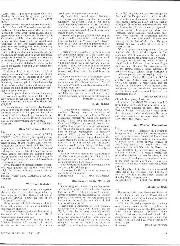
Full Marks, RAC
Sir, Having, read (in your November issue) of F.B.'s difficulties with an AA Travel claim, I feel I should relate my own, happier experience with an RAC Travel policy. After…
Sir, I have unearthed an engine which baffles me. It is a four-cylinder of about 2-litres capacity, with an aluminium plate on the side bearing the name Rover. The valves are at 90° and are operated by a
camshaft running along one side of the cylinder-head, the inlet valves through rockers and the exhaust valves by pushrods which lie horizontally in the head and rocker arms similar to those of the 2-litre Lagonda. The camshaft is driven from the rear of the crankshaft via skew gears and a long vertical shaft, and the valves, springs, and rockers are absolutely enormous in view of the small size of the manifold openings. Screwed on to the front of the head is an amusing little plate which states that if the fan-belt is not kept tight the engine will “thrash.”
There is a tremendous amount of tinware on the roads in this part of the world, nearly all uninteresting, notable exceptions being a very well-kept 3-litre Bentley with the original long sports wings and 3-seater pointed-tail body, a very nifty Alta which doesn’t seem to like traffic, also a 1i-litre Singer ” Le Mans” with a “Le Mans “24-hour plaque on the dash. My own conveyance these days for economy’s sake is a 7-h.p. Austin-1929 vintage, which has been persuaded to motor reasonably rapidly, the recipe being: Reduced frontal area ; body lowered 6 inches so that a starting-handle will not go in as the radiator is in the way ; new bearings right through ; crank reground and ends re-metalled with decent metal; rods polished, pistons by Wellworthy, aluminium high compression cylinderhead, valve-springs by Terry, valves by K.E.; carburation by a large downdraught S.U. through a special manifold and polished ports; flywheel turned down somewhat and clutch backed by stronger springs, and ignition by Scintilla. The crank and rods are of the later, 1932,
pattern. According to the rev.-counter, which is a new 6-in. Smith’s M.A., the engine will hold 5,500 r.p.m. without coming apart, but since the car was intended to go places and get there the 4.9 to 1 rear-axle is retained, so that the maximum speed isn’t anything to boast about. She steers fairly well, thanks to an extra set of Hartfords at the hinder end and an extra Austin shock-absorber at the front. If one contemplates going up trials hills it is advisable to slacken off the front shockers, as otherwise the crankcase is torn asunder by the twist of the chassis. The seating position necessitates a remote control 2 feet long, but she is quite comfortable to drive. I brought her home from Scotland to Sutton Coldfield with a passenger and all our kit after a fortnight at an R.A. camp, 358 miles, in exactly 10 hours by two good watches and I didn’t feel tired when I got home. She is built largely from bits scrounged, and panelled with alloy from an old Sunbeam and a few bits of old zinc poster-board. She only cost me 212 to buy and rebuild, including four new tyres.
Wishing you the very best of luck, and hoping that the next ” Donington Days” may not find us old, old men. I am, Yours etc.,
K. H. MILES, Bdr. Blackpool. [The engine is one of the ” 14/45 ” Rover units designed by Poppe and, we imagine, of about 1925 vintage. A ” 15.8 ” example was used in the singleseater Rover raced by the designer at the Track around 1926. We believe the production engine had a capacity of 2,121 c.c. (75 x 120 rrx.m.) and went off the market in 1927.—Ed.]